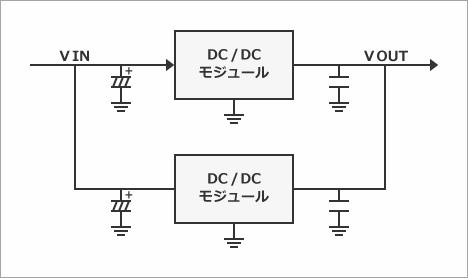This is Sasaki in charge of power supply dock technology.
In this column, I would like to introduce some examples of problems related to power supplies that I encountered multiple times during various customer support sessions.
We received an inquiry from a customer about the power supply circuit design for an FPGA-mounted board.
Parallel operation of power supply circuits required for large current

In revising the current board, we will change the FPGA to be used to a large one.
Considering the margin, we are thinking of doubling the current capacity to 60A.
(current board uses 30A power module)

So you are selecting a large capacity 60A power supply module?

No, I gave up on selecting a new high-capacity power supply module.
In fact, I can't expect much of the board after the revision, so I decided to connect the two 30A modules I'm using now in parallel, considering the price and availability of the power supply module.


Well, that's certainly a good idea.

Yes, at first I thought it would work, but...

Anything wrong?

When I short-circuited the outputs of the two modules and ran them in parallel, the output only increased to about 40A, and the modules generated a lot of heat...
Is there something wrong?

Could you please confirm the model number and circuit diagram of the module you are using?
Check the model number and schematic of the power supply module

Okay, now I know the reason.
The module you are using does not support parallel connection.
If such modules are connected in parallel, the more current is drawn, the worse the load balance will be, and the current will flow backward to one of the modules.
As a result, it seems that it was in a state where it could only output up to 40A.

If you use something that doesn't support parallel connection, you can't double the output. . .
Then, the only option is to select a new 60A module.

I agree.
Considering this, we recommend that you select modules that can be operated in parallel in advance from the next time.
Reason why the power output did not double
Reverse flow of current to one module due to the use of modules that do not support parallel connection
The point of this time

It is important to check whether the power supply IC or module has the function of parallel operation (Current Share).
(As the capacity of FPGA increases, we recommend using a power supply that can operate in parallel.)
Differences between parallel operation compatible/non-compatible power supply modules
Even if they are the same power supply module, there are actually some differences between them.
(example)
- Module A: Output voltage 3.30V
- Module B: Output voltage 3.25V
*Both modules A and B are the same product
When the above two modules are connected in parallel, there is no particular problem if the output current is small.
However, when the output current becomes very large (such as 60A for two combined as in this column), the current flows backward to module B, which has a slightly lower output voltage (module A is heavily loaded). larger), resulting in a lower output when connected in parallel.

Modules that support parallel operation have an internal output voltage balance adjustment function that eliminates the difference in output current between the two modules. This prevents the current from flowing back into one module and evenly loads both modules in parallel so that the output current does not drop.
Power supply modules that support parallel operation are often a little more expensive, but we recommend that you look ahead and select a product that supports parallel operation in advance. (When reselecting a large-capacity module, not only cost but also time and risk occur)
Click here for recommended articles/materials
Click here for recommended seminars/workshops
Analog solution power supply design seminar
Analog solution thermal design seminar
Basic seminar on power supplies for digital circuit designers


